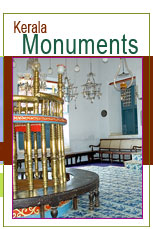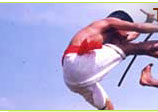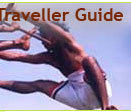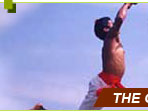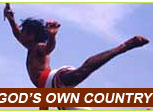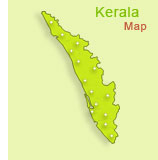¤¤ Kalari
The traditional training of Kalarippayattu a martial art of Kerala a small state in south India, is always done inside the Kalari which is specially constructed practicing area.Every Kalari have a Puttara (Meaning platform where flowers are kept in Malayalam language). Its a seven tired platform and located in the South-West corner of every Kalari. Here is where the guardian deity is located. Flowers, incense and water is given to the deity everyday. Before each person starts practicing they prey to the deity. Not only is the Kalari a temple of learning, it is also a temple of religious worship with a cult and ritual of its own.
¤¤ Construction of a Kalari
Traditionally the Kalari is constructed by digging the ground 4 feet in depth and removing the inside soil. This is usually called KuzhiKalari Kuzhi means portions formed by caving in the earth in Malayalam language.
The kalari will be facing the east, ie the entrance will be in the east. This is to get morning sun light. The length will be in the east-west. Another consideration taken when constructing the kalari is that it will be built in the south-west side of the main plot. Usually the length of the kalari will be 42 ft. in length (East-West) and 21 ft. in width (North-South). The floor will be leveled using mud. All kalari will have a Puttara in South-West corner.
¤¤ AnkaKalari and Ankathattu
Ankathattu is a four to six feet high platform constructed temporarily for the purpose of fighting duels. Ankam means war in Malayalam language. This platform will be constructed as per the tradition and will be in the center of the ground from where all peoples can watch the fight. This place altogether is called AnkaKalari.
Few centuries back if there is a quarrel between the local rulers, its finally solved by fixing an Ankam. Each ruler will be represented by an Ankachekavar meaning the person who is fighting for the ruler. The ruler of the Ankachekavar who wins the fight is considered as a winner.
¤¤ Kalarippayattu
Kalarippayattu is a martial art practiced in Kerala, a state in South India and in parts of Tamil Nadu. It combines self-defense techniques, religion, and has elements of "martial dance" as in Capoeira.
The word "Kalarippayattu" literally means 'combat training inside the gymnasium'. The word Kalari has been derived from the Sanskrit khalūrikā meaning a military training ground. Kalari in common terms means "gymnasium."
The traditional training of Kalarippayatt is always done inside the Kalari which is specially constructed practicing area. You will see Puttara (Seven tired platform) in the South-West corner of every Kalari. Here is where the guardian deity is located. Flowers, incense and water is given to the deity every day. Before each person starts practicing they pray to the deity. Not only is the Kalari a temple of learning, it is also a temple of religious worship with a cult and ritual of its own. You can read more about construction of a kalari in the article Kalari.
The Kalarippayatt training aims at something more at the ultimate co-ordination of mind and body. The weapon is only an extension of the body, controlled by the mind and the use of these both in attack and defence attain a very high degree of perfection.
¤¤ Main divisions of Kalarippayattu
........ ¤ Vadakkan Kalarippayattu (Northern style), which is associated with the Naboothiri, Nair and Ezhava communities of the Malabar region
........ ¤ Thekken Kalarippayattu (Southern style), is the style practiced in the Travancore area of Kerala. Roots can be traced back to the Sanghom period, when the southern parts of Kerala and Tamil Nadu were part of old "Thamizhakam". This is associated with the Nairs of South Travancore and also with the Tamil speaking communities of Maravars, Nadars and Vellalas there.
Vadakkan style involves more elaborate graceful body movements and southern style involves very rapid economical and yet powerful movements.
Thekken style are the Tamil martial arts practiced in the princely state of Travancore in the southern part of Kerala and the Kanyakumari district of neighboring Tamil Nadu that variously go by the names ati tata (hit/defend), ati murai (law of hitting), varma ati (Tamil)/marma ati (Malayalam) (hitting the vital spots), or cheena ati (Chinese hitting) (Zarrilli, 1992). These arts claim descent from the rishi Agastya and, compared to kalarippayattu, place more emphasis on empty-hand techniques and less on weapons.
¤¤ History of Kalaripayattu
The earliest reference to kalarippayattu occurs in A Description of the Coasts of East Africa and Malabar in the Beginning of the Sixteenth Century CE by Duarte Barbosa, indicating that kalarippayattu had already developed by this time.
Phillip B. Zarrilli, University of Exeter professor and one of the few Western authorities on kalaripayattu, estimates that kalarippayattu dates back to at least the 12th century CE.[1]
The historian Elamkulam Kunjan Pillai hypothesizes that kalarippayattu was a product of the battles between the Cheras and the Cholas during the 11th century CE. This theory was reiterated by later writers without question. Today, as the concept of the war has been questioned and rejected, the theory of the origin of Kalari during this war has lost its ground.
As stated earlier, the oldest suggested existence of Kalaripayattu date back to the 13th century CE. The earliest recorded evidence of Kalaripayyattu date from Portuguese descriptions during the latter 16th-17th centuries and becoming less prominent after the British outlawed it during the 18th and 19th centuries CE. It has recently been reinvigorated in the last few decades due to the general worldwide interest in martial arts.
There have been recent theories attempting to connect kalaripayattu with Shaolin Kung Fu through the legend of Bodhidharma, considered in Shaolin mythology as the founder of the Shaolin temple. This is not accepted by contemporary historians as the legends of Bodhidharma are conflicting and evidence exists for the existence of martial arts in the Buddhist temples in China prior to the purported arrival of Bodhidharma. For information on these disputes please read the article 'Disputed history of Kalarippayattu'
¤¤ Cultural influence
Vadakkan Kalaripayattu also shows a strong influence of Ayurveda and major classical dance forms of Kerala, namely Kathakali. Kalarippayyattu teachers often provide massages with traditional medicinal oils to their students in order to increase their physical flexibility or to treat muscle injuries encountered during practice. Such massages are generally termed "Thirumal" and the unique massage given to increase physical flexibility is known as "Katcha thirumal".
Thekkan kalari marmma treatment is much more sophisticated than the vadakkan uzhichil and the the science of vital points and the treatment related to them are being kept as secret knowledge, accessible only to the Guru, his family and his most trusted students. This treatment and the attacking of vital points are based on the Tamil palm leaf manuscripts of Sage Agasthya and his deciples.
¤¤ Training
A student begins his Kalarippayatt training at the very early age of 7 & 8 with a formal initiation ritual performed by the Master (Gurukkal). The training is mainly divided into 3 parts consisting of Meythari, Kolthari and Angathari. Apart from these, one more stage exists called Verumkai. (Please read these training stages in detail below). The above mentioned stages are for the vadakkan style. In the thekkan style the taining starts with Chuvadu (solo forms), Jodi(partner trainig/sparring), Kurunthadi, Neduvadi,Katthi, Katara,valum parichayum, Chuttuval, double sword and Marmma and kalari grappling. The Guru is called as "Asan"
Kalarippayattu training differs from most other martial arts training in that bare hand fighting skills are taught in the end. But this is not the case with the thekkan system. In the thekkan system the bare hand tactics are taught just after the solo forms and again when the students reaches high levels of proficiency the marmma or science of vital points are taught. Since it was originally the martial training given to warriors, the martial art teaches the practitioner to become adept in several different forms of weapons. The stages in which this training is imparted is:
A complete Kalarippayattu training is incomplete without learning the medical aspects. The practitioner who has completed martial training will be taught how to treat physical injuries with traditional medicines. A person who is well versed with all these aspects becomes a complete master and is called Kalari Gurukkal or simply Gurukkal.
¤¤ Initiation Ceremony
At the age of seven, on an auspicious day or on the opening day of the new session, a novice is admitted to the kalari in the presence of the Gurukkal or a senior student, and directed to place his right foot first across the threshold. The student touches the ground with the right hand and then his forehead, as a sign of respect. He is then led to the Guruttara to repeat his act of worship. He then has to offer some money in folded betel leaves as dakshina (tuition fee) for the master and bow and prostrate himself before the latter, and touch his legs, as a sign of submission. The guru then places his hands on the pupil’s head, blesses him and prays for him. This worship; touching the ground, Poottara, Guruttara and the guru’s feet, is to be repeated everyday. It symbolizes a complete submission to and acceptance of the Kalari deities, Kalari master, and the rules and discipline of the art
¤¤ Meythari
This is the beginner stage where rigorous body sequences comprising of twists, stances and complex jumps and turns are to be mastered. After the basic postures of the body twelve sequences of body control exercises are practiced, these exercises are termed as Meyppayattu and they impart excellent neuro muscular co-ordination in the practitioner. This is the stage of training leading to balance and flexibility.
¤¤ Kolthari
Once the student has become physically competent, he/she is introduced to fighting with long wooden weapons.
The first weapon taught is the cane staff which is usually 5 feet in length, or up to the forehead of the student from the ground level called "Kettukari".
The second weapon taught is a short wooden stick of about two and a half feet, or three palm spans. This is called the "Cheruvadi" or "Muchan".
The third weapon taught is "Otta" which is a wooden staff curved to resemble the trunk of an elephant. The tip is rounded and is used to strike the vital spots in the opponent's body. This wepon is considerd as the master weapon. The training in 'Otta' consists of 18 sequences. This tool remains the fundamental tool of practice to develop stamina, agility, power, and skill.
¤¤ Ankathari
Ankathari means training in warfare. Once the practitioner has gained confidence with all the wooden weapons, he/she is introduced to metal weapons, which require superior concentration due to the lethal nature of such weapons.
The first weapon taught is the metal dagger called "Kadhara" which has a curved blade. The second weapon taught is the sword and shield. The sword is called "Val" and the shield is called "Paricha" The sword and shield exercises are very elegant to look at.
There are more weapons taught, including a wooden spear called the kuntham and the famous flexible sword called Urumi or Chuttuval which is an extremely dangerous weapon, and as such is taught rarely, to only the most skillful of students.
Historically, after the completion of 'Ankathari' training, the student would specialize in a weapon of his choice, to become an expert swordsman or stick fighter.
¤¤ Verumkai
Only after achieving mastery with all weapons forms is the practitioner taught to defend his/her person with bare-handed techniques. These include strikes to vital pressure points of the body (called Marmam), grapples, and arm locks. The knowledge about marmam is taught by the "Kalari Gurukkal" to only the students whom he trusts. Presently only very few people are trained to hit the marmam
¤¤ Vativu (Postures) and Chuvatu (Foot movements)
Atavu which is a combination of Vativu and Chuvatu.
Vativu: There are nine Vativus or postures in Kalarippayattu they are:
........ ¤Gaja Vativu or elephant pose
........ ¤Aswa Vativu or horse pose
........ ¤ Simha Vativu or Lion pose
........ ¤Varaha Vativu or boar pose
........ ¤Matsya Vativu or Fish pose
........ ¤ Marjara Vativu or Cat pose
........ ¤Kukkuta Vativu or Cock pose
........ ¤Sarpa Vativu or Serpant pose
........ ¤Mayura Vativu or Peacock pose
Each postures has its own style, power combination, usefulness and effectiveness.
Chuvatu: There are five Chuvatus or foot positions and movements they are:
........ ¤Vatta Chuvatu
........ ¤Aakka Chuvatu
........ ¤ Neekka Chuvatu
........ ¤Kon Chuvatu
........ ¤Ottakkal Chuvatu
One should be a master in all the foot movements if one really wants to master Kalarippayattu.
¤¤ Weapons used by Kalarippayattu warriors
1. Pirambu/Neduvati/Kettukari/Shareeravadi (long staff)
2. Kurunthadi/Cheruvadi/Muchhan (medium stick)
3. Kuruvadi (short stick)
4. Kottukampu or Thavikkana (names for sticks)
5. Otta (curved stick)
6. Gadha (club, mace)
7. Kattari (knife/dagger)
8. Vettukathi (a machete or kukri)
9. Churika/Kadhara (short sword)
10. Val (sword)
11. Paricha (round shield)
12. Kuntham (spear)
13. Urumi/Chuttuval (flexible sword)
Medieval literature also refers to these other weapons:
1. Ponti
2. Bow and arrow
3. Venmazhu(axe)
4. Kathuthala
5. Trisool (trident)
|

